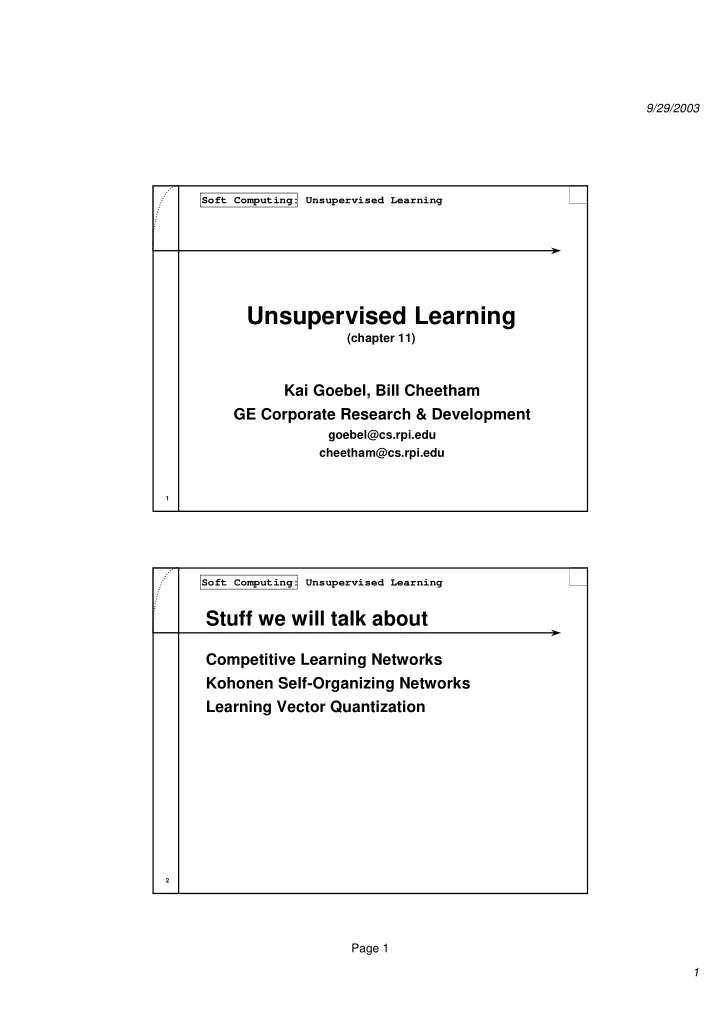

9/29/2003 Soft Computing: Unsupervised Learning Unsupervised Learning (chapter 11) Kai Goebel, Bill Cheetham GE Corporate Research & Development goebel@cs.rpi.edu cheetham@cs.rpi.edu 1 Soft Computing: Unsupervised Learning Stuff we will talk about Competitive Learning Networks Kohonen Self-Organizing Networks Learning Vector Quantization 2 Page 1 1
9/29/2003 Soft Computing: Unsupervised Learning Introduction When no teacher or critic is available, only the input vectors can be used for learning. Learning system categorizes or detects features without feedback => use for clustering, feature extraction, similarity detection, data mining 3 Soft Computing: Unsupervised Learning Competitive Learning Winner takes all: Weights of the unit with highest activation are updated The weight vector rotates slowly towards the cluster centers w 11 1 x 1 2 x 2 3 x 3 w 34 4 4 Page 2 2
9/29/2003 Soft Computing: Unsupervised Learning Competitive Learning Activation of output unit j 3 ( ) 2 � = − = − a x w x w j i ij j = 1 i and the weights are updated according to: ( ) ( ) ( ) ( ) ( ) 1 w t + = w t + η x t − w t k k k Note: different metrics can be used leading to different solutions If initial weights are far from actual centers: may never get updated; 5 => use leaky learning Soft Computing: Unsupervised Learning Self-Organizing Networks (Kohonen) • Learning is similar to Competitive Learning • Not only the winning units are updated but all the weights in a neighborhood • Size of neighborhood decreases • Topological properties in the input data is reflected in the output units through neighborhood constraints 6 Page 3 3
9/29/2003 Soft Computing: Unsupervised Learning Self-Organizing Networks Algorithm - Step 1 Select winning output (smallest dissimilarity) min − = − x w x w c i i - Step 2 Update winners and neighborhood NB c of winner c ( ) ∈ ∆ w = η − i NB c x w i i Reduce η η gradually η η 7 Soft Computing: Unsupervised Learning Learning Vector Quantization (LVQ) Adaptive data classification 1. Cluster data (using any clustering tool) 2. Label data using majority of data in cluster “voting method” Fine tune class information to minimize errors by 3. Finding cluster center closest to input 4. If x and w k belong to the same class: ( ) ∆ w = η − x w k k otherwise ( ) ∆ w = − η − x w k k Repeat until max. number of iterations reached 8 Page 4 4
9/29/2003 Soft Computing: Unsupervised Learning Adaptive Resonance Theory (ART) - Accept and adapt stored prototypes of a class when the input is sufficiently similar to it. - Input and stored prototype are said to “resonate”. - If the input is not sufficiently similar to any class, then form a new class. - Similarity is judged by a “vigilance” level - ART1 focuses on binary input. - ART2 designed for continuous input. 9 Soft Computing: Unsupervised Learning ART1 Algorithm 1. Enable all output units 2. Find the winner among all enabled output units by comparing the components of the input vector. 3. Check whether the match is good enough by comparing the ratio of bits in input and prototype to vigilance level 4. If the match is good, adjust winning vector by adjusting any bits that are not also in input vector. 5. If the match is not good enough, create a new class by adding the current vector as a class prototype. 10 Page 5 5
9/29/2003 Soft Computing: Unsupervised Learning last slide 11 Page 6 6
Recommend
More recommend